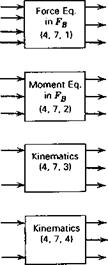The above equations are quite general and contain few assumptions. These are:
1. The airplane is a rigid body, which may have attached to it any number of rigid spinning rotors.
2. Cxz is a plane of mirror symmetry.
3. The axes of any spinning rotors are fixed in direction relative to the body axes, and the rotors have constant angular speed relative to the body axes.
The equations of Sec. 4.7 are many and complex. They consist of 15 coupled nonlinear ordinary differential equations in the independent variable t, and three algebraic equations. Before we can identify the true dependent variables, however, we must first consider the aerodynamic forces (X, Y,Z) and moments (L, M,N). It is clear that these must depend in some manner on the relative motion of the airplane with respect to the air, given by the linear and angular velocities V and to, on the control variables that fix the angles of any moveable surfaces and on the settings of any propulsion controls that determine the thrust vector. Thus it is universally assumed in flight dynamics that the six forces and moments are functions of the six linear and angular velocities (u, v,w, p,q, r) and of a control vector. The latter clearly depends to
some extent on the particular airplane, but we can, with adequate generality, write it
as
c = [Su gr 8PY
of which the first three are the familiar aileron, elevator, and rudder angles, and the last is the throttle control. Other components can be added to the control vector as needed to meet special requirements—for example, direct lift control. The control variables, from the standpoint of the mathematical system, are arbitrary functions of time. How they are determined is the subject of later sections. The wind vector whose components appear in (4.7,5) would ordinarily be a known function of position rc with its components given in frame FE. Its components in FB are W/; = LS£W£.
The true implicit dependent variables of the system are thus seen to be 12 in number:
CG position: xE, yE, zE Attitude: ф, в, ф Velocity: uE, vE, we Angular velocity: p, q, r
Of the 15 differential equations we note that 3 of (4.7,3) are not independent, so the number of independent equations is actually 12, the same as the number of dependent variables. The mathematical system is therefore complete.
A useful view of the equations is given in the block diagram of Fig. 4.4, which is specialized to the case of zero wind. Each block represents one set of equations, with inputs and outputs (the dependent variables). All the inputs needed for the left-hand side are generated as outputs on the right, except for the control inputs, which remain to be specified. The nature of the mathematical problem that ensues is very much










 {]>—– “
{]>—– “
fl>—– o
ф——- »
-Q>—- p
—— «
Q>——–
■D>— Ф
■Q>—- 8
{D—*
{D— XE
-П>—- Уе
-Q>– ZE
Figure 4.4 Block diagram of equations for vehicle with plane of symmetry. Body axes. Flat-Earth approximation. No wind.
governed by the specifics of the control inputs. In the following paragraphs, we discuss the various cases that commonly occur in engineering practise and in research.













 the right. In this case, the two products of inertia, Ixy and lyz, are zero, and (4.5,9) are consequently simplified.
the right. In this case, the two products of inertia, Ixy and lyz, are zero, and (4.5,9) are consequently simplified.